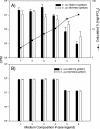Effect of pH on intracellular accumulation of trace concentrations of Hg(II) in Escherichia coli under anaerobic conditions, as measured using a mer-lux bioreporter
- PMID: 18083863
- PMCID: PMC2227699
- DOI: 10.1128/AEM.00717-07
Effect of pH on intracellular accumulation of trace concentrations of Hg(II) in Escherichia coli under anaerobic conditions, as measured using a mer-lux bioreporter
Abstract
The effects of pH on the uptake and accumulation of Hg(II) by Escherichia coli were determined at trace, environmentally relevant, concentrations of Hg and under anaerobic conditions. Hg(II) accumulation was measured using inducible light production from E. coli HMS174 harboring a mer-lux bioreporter plasmid (pRB28). The effect of pH on the toxicity of higher concentrations of Hg(II) was measured using a constitutive lux plasmid (pRB27) in the same bacterial host. In this study, intracellular accumulation and toxicity of Hg(II) under anaerobic conditions were both significantly enhanced with decreasing pH over the pH range of 8 to 5. The pH effect on Hg(II) accumulation was most pronounced at pHs of <6, which substantially enhanced the Hg(II)-dependent light response. This enhanced response did not appear to be due to pH stress, as similar results were obtained whether cells were grown at the same pH as the assay or at a different pH. The enhanced accumulation of Hg(II) was also not related to differences in the chemical speciation of Hg(II) in the external medium resulting from the changes in pH. Experiments with Cd(II), also detectable by the mer-lux bioreporter system, showed that Cd(II) accumulation responded differently to pH changes than the net accumulation of Hg(II). Potential implications of these findings for our understanding of bacterial accumulation of Hg(II) under anaerobic conditions and for bacteria-mediated cycling of Hg(II) in aquatic ecosystems are discussed. Arguments are provided suggesting that this differential accumulation is due to changes in uptake of mercury.
Figures







Similar articles
-
Role of Na+ in transport of Hg2+ and induction of the Tn21 mer operon.Appl Environ Microbiol. 1994 Oct;60(10):3503-7. doi: 10.1128/aem.60.10.3503-3507.1994. Appl Environ Microbiol. 1994. PMID: 7986028 Free PMC article.
-
Evaluation of mercury toxicity as a predictor of mercury bioavailability.Environ Sci Technol. 2007 Aug 15;41(16):5685-92. doi: 10.1021/es070138i. Environ Sci Technol. 2007. PMID: 17874774
-
Effect of inorganic and organic ligands on the bioavailability of methylmercury as determined by using a mer-lux bioreporter.Appl Environ Microbiol. 2012 Oct;78(20):7276-82. doi: 10.1128/AEM.00362-12. Epub 2012 Aug 3. Appl Environ Microbiol. 2012. PMID: 22865079 Free PMC article.
-
The evolution of the bacterial luciferase gene cassette (lux) as a real-time bioreporter.Sensors (Basel). 2012;12(1):732-52. doi: 10.3390/s120100732. Epub 2012 Jan 11. Sensors (Basel). 2012. PMID: 22368493 Free PMC article. Review.
-
Bacterial resistances to inorganic mercury salts and organomercurials.Plasmid. 1992 Jan;27(1):4-16. doi: 10.1016/0147-619x(92)90002-r. Plasmid. 1992. PMID: 1311113 Review.
Cited by
-
A quantitative method to assess bacterial adhesion using recombinant bioluminescent Pseudomonas aeruginosa.Biophys Rep. 2021 Feb 28;7(1):55-70. doi: 10.52601/bpr.2021.200043. Biophys Rep. 2021. PMID: 37288086 Free PMC article.
-
Mercury bioaccumulation in zooplankton and its relationship with eutrophication in the waters in the karst region of Guizhou Province, Southwest China.Environ Sci Pollut Res Int. 2020 Mar;27(8):8596-8610. doi: 10.1007/s11356-019-07479-8. Epub 2020 Jan 6. Environ Sci Pollut Res Int. 2020. PMID: 31907806
-
Determination of Hg(II) and Methylmercury by Electrothermal Atomic Absorption Spectrometry after Dispersive Solid-Phase Microextraction with a Graphene Oxide Magnetic Material.Molecules. 2022 Dec 20;28(1):14. doi: 10.3390/molecules28010014. Molecules. 2022. PMID: 36615211 Free PMC article.
-
Fish mercury and surface water sulfate relationships in the Everglades Protection Area.Environ Manage. 2014 Mar;53(3):583-93. doi: 10.1007/s00267-013-0224-4. Epub 2014 Jan 3. Environ Manage. 2014. PMID: 24385066 Free PMC article.
-
A suite of recombinant luminescent bacterial strains for the quantification of bioavailable heavy metals and toxicity testing.BMC Biotechnol. 2009 May 8;9:41. doi: 10.1186/1472-6750-9-41. BMC Biotechnol. 2009. PMID: 19426479 Free PMC article.
References
-
- Barkay, T., R. R. Turner, L. D. Rasmussen, C. A. Kelly, and J. W. M. Rudd. 1998. Luminescence facilitated detection of bioavailable mercury in natural waters, p. 231-246. In R. A. Rossa (ed.), Bioluminescence methods and protocols. Humana Press, Totowa, NJ. - PubMed
-
- Barkay, T., S. M. Miller, and A. O. Summers. 2003. Bacterial mercury resistance from atoms to ecosystems. FEMS Microbiol. Rev. 27:355-384. - PubMed
-
- Beard, S. J., R. Hashim, G. Wu, M. R. B. Binet, M. N. Hughes, and R. K. Poole. 2000. Evidence for the transport of zinc(II) ions via the Pit inorganic phosphate transport system in Escherichia coli. FEMS Microbiol. Lett. 184:231-235. - PubMed
-
- Benoit, J. M., C. C. Gilmour, and R. P. Mason. 2001. Aspects of bioavailability of mercury for methylation in pure cultures of Desulfobulbus propionicus (1pr3). Environ. Sci. Technol. 35:127-132. - PubMed
Publication types
MeSH terms
Substances
LinkOut - more resources
Full Text Sources
Medical
Molecular Biology Databases
Miscellaneous

